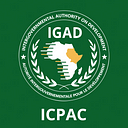Pursuing Sustainable Development Goal 15: Progress and Challenges in Protecting Life on Land

By Jebet Vicky
With contributions from the IGAD Climate Change Technical Working Group
The world recognizes the importance of protecting and restoring terrestrial ecosystems, which are vital for human well-being, biodiversity conservation, and addressing climate change. The Sustainable Development Goal (SDG) 15, Life on Land, specifically aims to protect, restore, and sustainably manage terrestrial ecosystems and halt deforestation. Positive strides include establishing protected areas, rehabilitating degraded lands, conserving endangered species, and developing policy frameworks.
Data plays a crucial role in monitoring the achievement of SDG 15 and scaling up the implementation of its targets. Global Monitoring for Environmental Security and Africa (GMES and Africa) catalyzes policy-makers, planners, scientists, the private sector, and individuals to design, implement and monitor policies at all levels through Earth Observation data.
GMES and Africa work with partners, e.g., Kenya Wildlife Service and Uganda Wildlife Authority, to integrate data into their workflows and processes like protected areas management plans, biodiversity, and research monitoring, enhancement of products and services through integration with existing data systems, e.g., East Africa Drought Watch and in-situ data from partners, e.g., wildlife census data.
Most countries have acknowledged the significance of SDG 15, and they have integrated it into their national policies and plans. Governments have undertaken several actions to support this goal, such as establishing protected areas, formulating sustainable land management strategies, and promoting biodiversity conservation (United Nations, 2023).
In Kenya, for instance, the government has developed several policies and legislation to effectively implement SDG 15, including the Environmental Policy, Education for Sustainable Development Policy, Wetlands Conservation and Management Policy, and Chemicals Management Policy.
Additionally, they have reviewed the Environmental Management and Coordination Act of 1999, enacted the Forest Conservation and Management Act of 2016 and the Climate Change Act of 2016, and developed the Green Economy Strategy and Implementation Plan, as well as the National Forest Program for the period of 2016–2030 (GOK, 2019).
Governments and organizations globally have committed to expanding protected areas, increasing the coverage of natural ecosystems, and restoring degraded lands e.g through reforestation projects. These initiatives have multiple benefits, such as combating deforestation, restoring wildlife habitats, improving soil quality, and mitigating climate change by sequestering carbon emissions.

The Great Green Wall Initiative of Africa, launched in 2007 by the African Union, is an example of a large-scale reforestation initiative. Spanning 8,000km across 22 African countries, this initiative aims to restore 100 million hectares of land, sequester 250 million tons of carbon, and create 10 million green jobs by 2030. The Initiative allows each country to address land degradation, climate change adaptation and mitigation, biodiversity, and forestry within its local context, leading us closer to the achievement of SDG 15.
Despite the progress made, achieving SDG 15 still lags behind due to several challenges. One of the primary challenges identified in the Voluntary National Review (VNR) reports is deforestation and land degradation (UN DESA, 2021). The world has experienced a decline in forest area, losing 100 million hectares between 2000 and 2020, with the main driver of deforestation being agricultural expansion, accounting for 90% of global deforestation (United Nations, 2023).
As land degradation and desertification continue to pose significant challenges, there is an urgent need for increased efforts to combat these issues. Implementing sustainable land management practices, such as soil conservation, afforestation, and preventing soil erosion, is crucial in reversing the damage done to the land. It is the collective responsibility of governments and stakeholders to prioritize adopting sustainable agricultural practices, including agroforestry, to ensure both food security and the preservation of land productivity.
Several cross-cutting challenges intersect with SDG 15, such as climate change, poverty, and inequality. Climate change impacts (rising temperatures, changing precipitation patterns, and increased frequency of extreme weather events) on land and ecosystems pose significant threats to biodiversity loss (UN DESA 2021).
A distressing example is the recent prolonged drought in the Horn of Africa, which caused the death of over 70 elephants in 2021 in Kenya alone (Born Free, 2021). It is therefore crucial to integrate climate change adaptation and mitigation strategies into initiatives related to SDG 15. By doing so, we can support biodiversity conservation goals, sustainable land management, and promote resilient ecosystems.

The implementation of SDG 15 requires significant financial resources and technical expertise. Many developing countries need help accessing adequate funding and building the capacity to effectively manage and conserve terrestrial ecosystems.
While commendable progress has been made, achieving SDG 15 requires collaboration, innovation, and global solidarity. Governments, communities, businesses, and individuals must prioritize these goals in their decision-making processes, policy frameworks, and daily actions. Working together can pave the way for a sustainable and resilient future, ensuring that our planet thrives for future generations.
“Unless we act now, the 2030 Agenda will become an epitaph for a world that might have been.” António Guterres.
